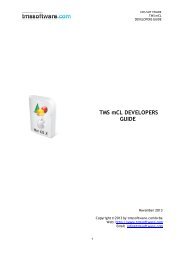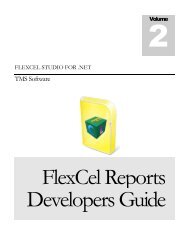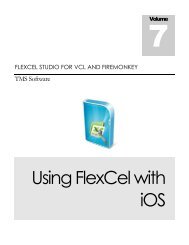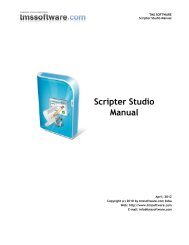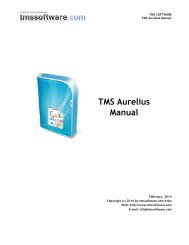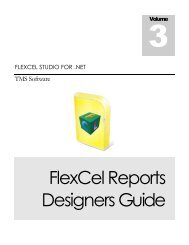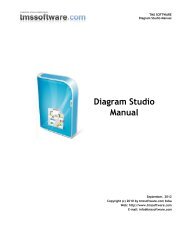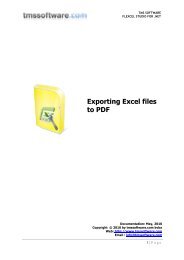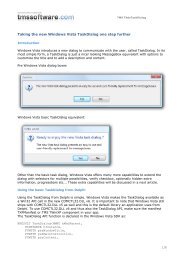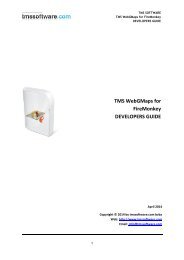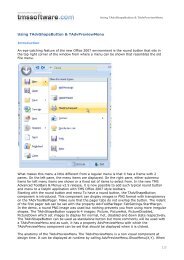Flexcel Reports Designers Guide - TMS Software
Flexcel Reports Designers Guide - TMS Software
Flexcel Reports Designers Guide - TMS Software
You also want an ePaper? Increase the reach of your titles
YUMPU automatically turns print PDFs into web optimized ePapers that Google loves.
<strong>TMS</strong> SOFTWARE<br />
FLEXCEL STUDIO FOR .NET<br />
Note that the generated master table is a “pseudo table” n the sense that it has no columns or<br />
data, but it has (DetailRecords.Count – 1) / NumberOfRecords + 1 rows. Also the relationship<br />
between the master and the detail is not on real columns, since there are no columns on the<br />
master. This creates a limitation on how you can use those tables, and it is that the master should<br />
have the detail as a direct child. You cannot have other __ range__ between them, or FlexCel will<br />
complain.<br />
Take a look at the Split Datasets demo for more information.<br />
Retrieving TOP N Records from a table<br />
You normally should filter the data when retrieving it from the database (for example with the SQL<br />
“Select top 10 * from customers”). But if this is not possible, you can use the Top(source, number of<br />
records) tag to filter this from the template. Be careful with this tag. If your table has 10,000<br />
records and you only need 10, fetching them all from the db in order to use only 10 is not a smart<br />
idea. Take a look at the Fixed Forms With Datasets demo for more information.<br />
Direct SQL on templates<br />
Depending on your needs, you might want to write SQL commands directly on the templates and<br />
avoid having a Data module on code. This allows the users to modify the data they need by<br />
modifying the xls file, and without recompiling the executable.<br />
!<br />
But, before you continue reading, be aware that allowing your users to directly write<br />
the SQL commands can mean a big security risk.<br />
For example, a user could use the connection you give him to execute the SQL: “drop<br />
table users” instead of a normal select. While FlexCel does a little validation on the<br />
SQL written by the user (for example, it cannot contain “;” or “--”, it has to start<br />
with “Select” etc) SQL is a very powerful language and there can always be a way to<br />
execute a command on the server. And, even if the user does not manage to execute a command,<br />
he might always do a “Select user, password from users” or similar command, and get dbadmin<br />
access to the database.<br />
So, you must supply a readonly connection, and with rights limited to the tables you want the<br />
user to see.<br />
The steps for allowing Direct SQL on the templates are:<br />
1. Provide a connection to the report, by using FlexCelReport.AddConnection()<br />
2. On the config sheet, “Source Name” column, add a string like “SQL(Select * from clients”).<br />
Give this table a name, and you can use it as any other table on the report.<br />
Note that also for security reasons, you can't replace expressions inside the SQL string. For example,<br />
you can't write “SQL(select * from customers where cust_id = )” This would open another<br />
security hole and allow for SQL injection attacks.<br />
SQL Parameters<br />
You need to specify database parameters to be able to actually pass information to the SQL.<br />
.NET can use both positional (“”) and named (“@name” or “:name”) parameters, and some data<br />
providers will accept one or the other. As we want to keep the template database independent (so<br />
you can replace the db backend without changing templates), all parameters on the template are<br />
18 | P a g e



